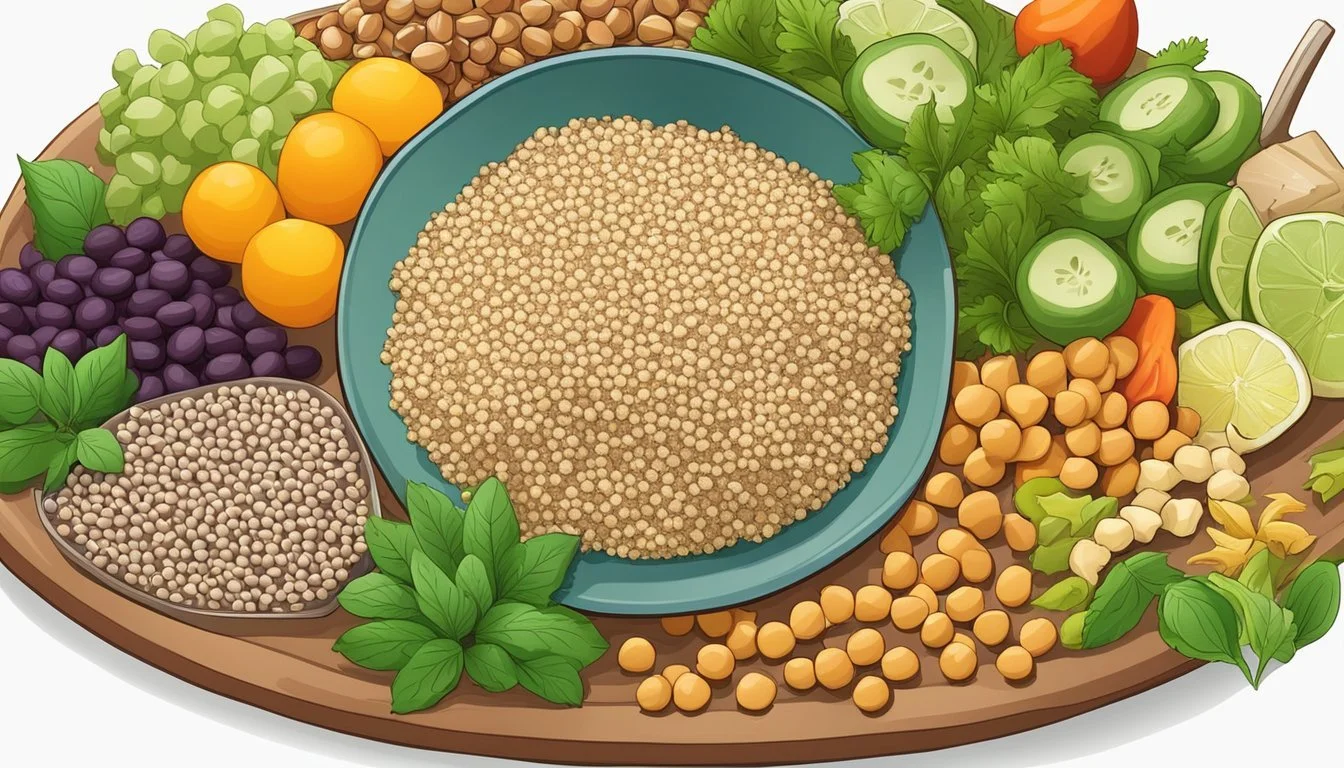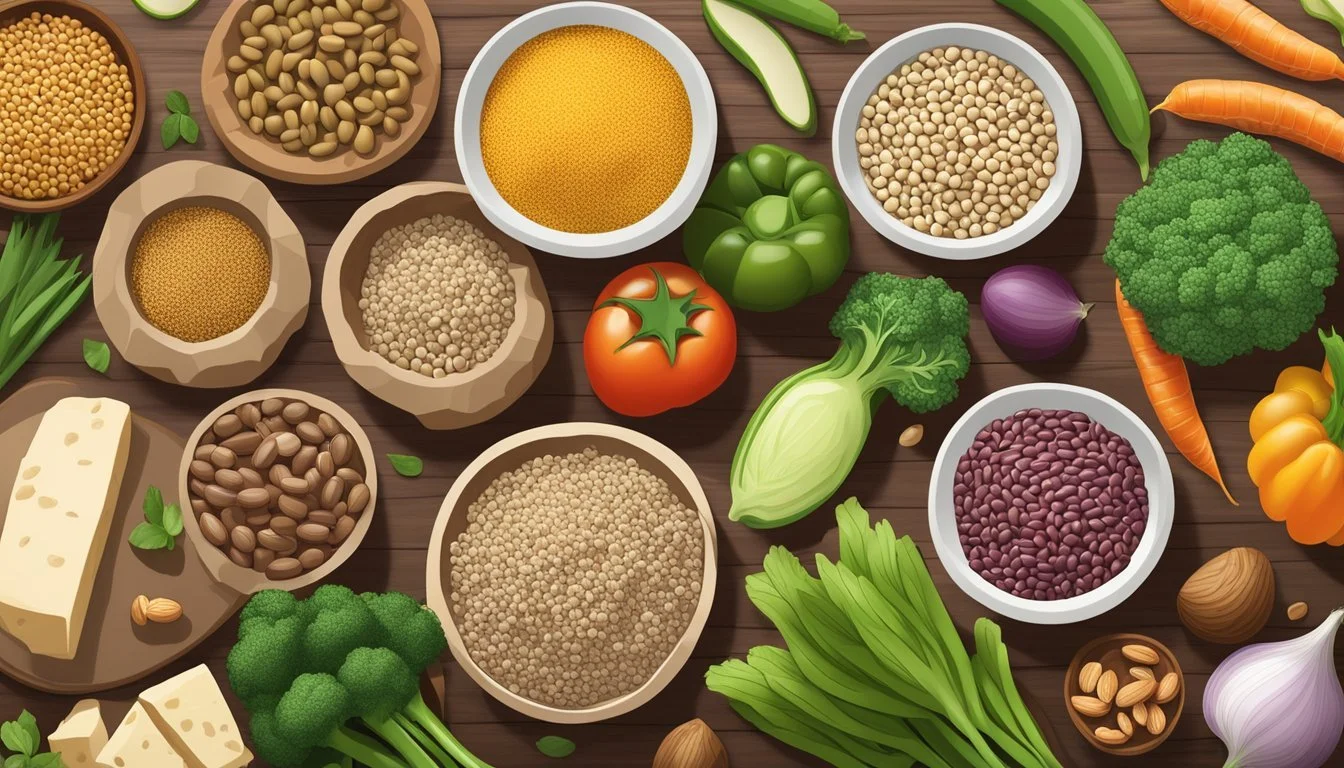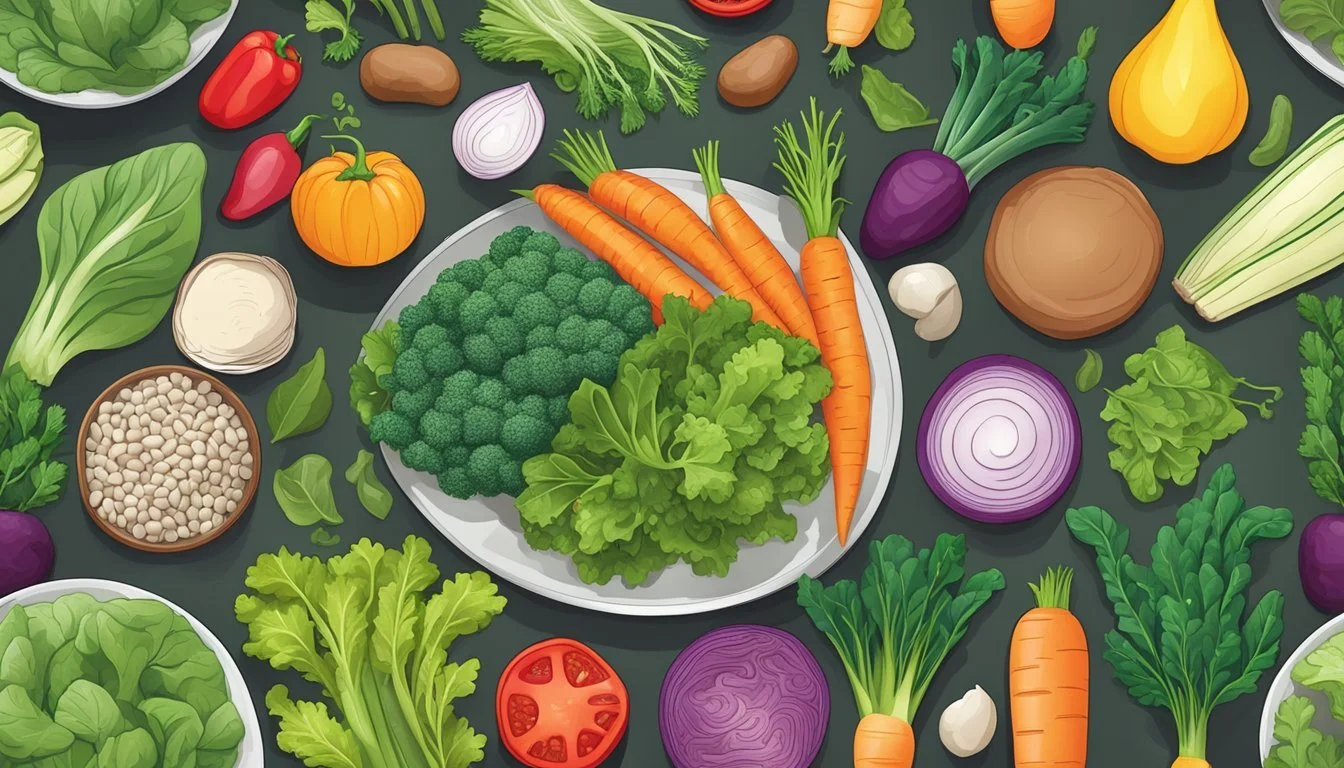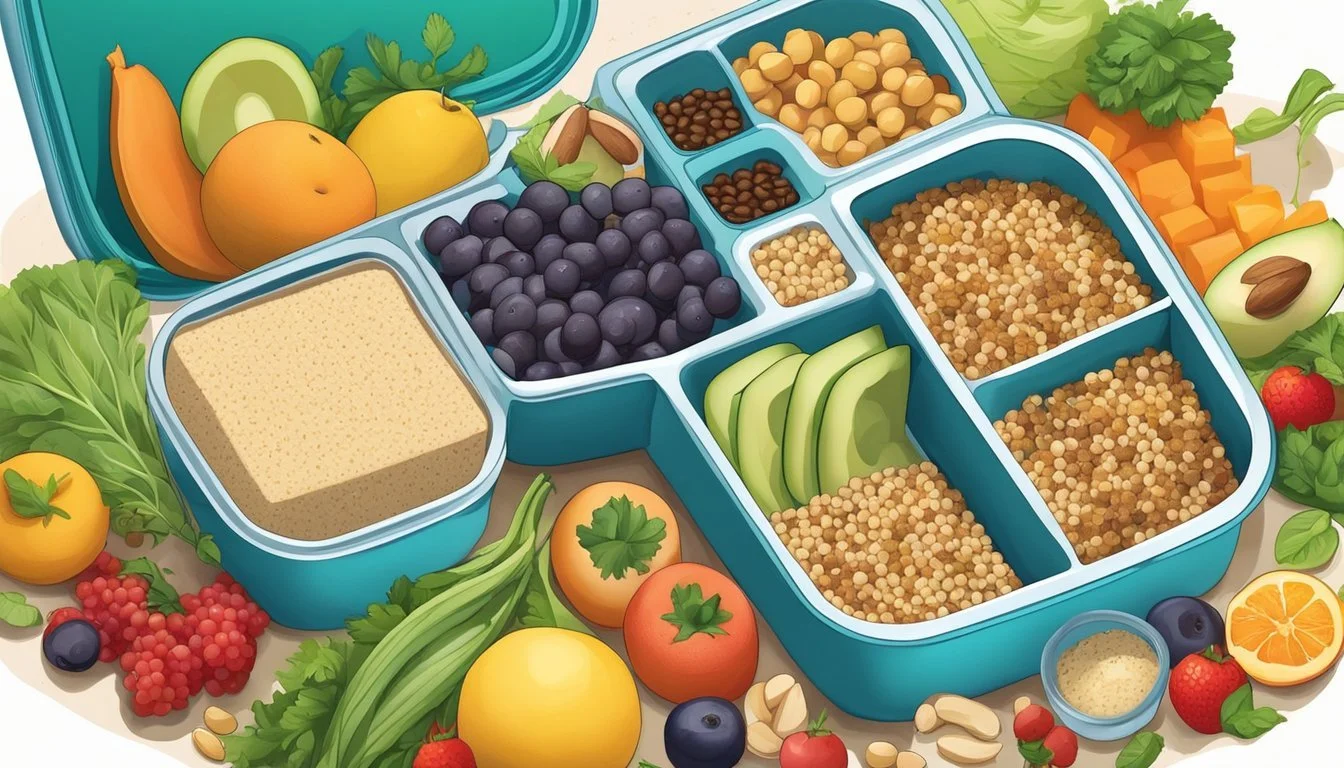Best Foods for a Protein-Packed Lunch Without Meat
Top Plant-Based Picks
Protein is an essential macronutrient for the human body, serving as a building block for muscles, producing enzymes and hormones, and supporting tissue repair. Traditionally, meat is recognized as a primary source of protein, yet it's not the only way to fulfill the body's protein needs. Many non-meat options provide ample amounts of protein, making them excellent choices for those looking for vegetarian or meatless lunches (What wine goes well with lunch?). These protein-packed alternatives can be just as satisfying and healthful, contributing to a balanced diet that supports overall health and nutrition.
For individuals seeking to incorporate more plant-based nutrition into their midday meals, there are abundant protein-rich food options that can keep them energized throughout the day. Lunch ideas that harness the nutritional power of legumes, grains, and vegetables can be both delicious and nourishing. Foods like quinoa, (What wine goes well with quinoa?) beans, tofu, and tempeh (What wine goes well with tempeh?) serve as versatile protein sources that can be incorporated into a variety of lunchtime recipes. Alongside these, incorporating nuts like almonds into dishes or enjoying vegetables with significant protein content, such as broccoli and spinach, adds both flavor and nutritional value.
These protein-rich alternatives not only align with a health-conscious approach but also offer a world of culinary possibilities. From hearty salads and grain bowls brimming with black beans or lentils to savory soups infused with white beans, these foods provide substantial protein without relying on meat. Crafting a nutritious, protein-packed lunch without meat involves exploring different combinations of these ingredients to create satisfying and balanced meals suitable for any diet or lifestyle.
The Role of Protein in a Healthy Diet
Protein is fundamental for maintaining bodily functions and muscle repair. It should be included in one's diet to meet daily nutritional needs while promoting a state of well-being.
Benefits of Protein
Protein, composed of amino acids, is essential for building and repairing tissues in the body. It serves as a building block for muscles, bones, skin, and blood. Amino acids, the building blocks of proteins, are necessary for the synthesis of hormones and enzymes. Some are produced by the body, while others, known as essential amino acids, must be obtained through diet.
In addition to its structural role, protein contributes to a feeling of fullness, which can aid in managing appetite and supporting weight management goals. This macronutrient is also critical for immune health, aiding in the production of antibodies to fight infection.
Protein Intake and Requirements
An individual's protein intake should align with their activity level, age, and overall health. The Recommended Dietary Allowance (RDA) for protein is 0.8 grams per kilogram of body weight per day for adults. To personalize this:
Sedentary adult: 0.8g/kg
Active adult: 1.0-1.2g/kg
Elderly: Up to 2.0g/kg to prevent muscle loss
Consuming a variety of protein sources helps ensure a person receives all essential amino acids. Protein-rich foods also often provide other important nutrients such as fiber, vitamins, and minerals. For a balanced diet, these foods should be paired with fruits, vegetables, and whole grains to create a nutrient-dense meal.
Vegetarian Proteins: An Overview
Protein is a vital nutrient for everyone, and for those following a vegetarian diet, it is important to include a variety of protein-rich foods to meet daily nutritional needs. This section provides a concise guide to vegetarian proteins that can transform lunchtime into a nutritious, protein-packed meal.
Legumes and Beans
Legumes and beans are foundational blocks of vegetarian nutrition, offering a substantial amount of protein. For instance, lentils bring approximately 18 grams of protein per cooked cup to the table. Moreover, they are an excellent source of fiber, aiding in digestion and overall health. Chickpeas and black beans are also high on the list, versatile for any meal and serving around 15 grams of protein per cup.
Lentils: 18g protein/cup (cooked)
Black Beans: 15g protein/cup (cooked)
Chickpeas: 15g protein/cup (cooked)
Dairy and Eggs Options
Dairy products and eggs are prominent sources of high-quality protein for vegetarians. Greek yogurt stands out with 20 grams of protein per 7-ounce serving, while a single large egg offers 6-8 grams of protein. These foods not only contribute to protein intake but also provide other essential nutrients like calcium and vitamin B12.
Greek Yogurt: 20g protein/7 oz
Eggs: 6-8g protein/large egg
Nuts and Seeds
Apart from being convenient snacks, nuts and seeds are densely packed with protein. Almonds and sunflower seeds can be counted on for a healthy protein boost with roughly 6 grams of protein per ounce.
Almonds: 6g protein/oz
Sunflower Seeds: 6g protein/oz
Soy Products
Soy products, particularly tofu, tempeh, and edamame, are the powerhouse of vegetarian protein choices. Tofu is a genuine all-rounder with 12-20 grams of protein per 3.5 ounces (100g), while tempeh, a fermented soy product, offers a similar protein content. Edamame, or, young soybeans, are savory and protein-laden, ideal to complement any vegetarian lunch.
Tofu: 12-20g protein/3.5 oz (100g)
Tempeh: similar to tofu
Edamame: Young soybeans, typically served in pods
High-Protein Vegetables and Greens
Incorporating a variety of high-protein vegetables and leafy greens into a lunch can provide essential nutrients such as fiber, antioxidants, vitamins, and minerals in a meat-free diet.
Leafy Greens
Spinach is a superior choice for a protein-packed lunch, offering 6 grams of protein per cup. Additionally, it delivers a wealth of nutrients, including vitamin A, vitamin K, and vitamin C, all crucial for supporting a healthy immune system, maintaining good vision, and promoting proper blood flow.
Kale is nearly on par, boasting high protein levels and also contributing to a robust intake of nutrients. A cup of kale provides the body with essential nutrients and fiber.
Colorful Vegetable Proteins
Broccoli stands out with its high protein content coupled with a rich supply of vitamins and minerals. It is not only a powerful source of fiber but also bolsters the body's defenses with its antioxidant properties.
Artichokes (What wine goes well with artichokes?) and asparagus rank well in the protein department among vegetables, making them excellent choices for adding substance and nutritional value to meals. A medium artichoke has about 4 grams of protein, and a cup of asparagus offers roughly 3 grams.
Carrots, although not as high in protein as the aforementioned options, are still beneficial, contributing important antioxidants and nutrients to the diet.
By choosing from these protein-rich vegetables and greens, one can ensure a nutritious lunch without depending on meat.
Creative Protein-Packed Lunch Ideas Without Meat
When it comes to powering through the day, lunchtime is crucial, and incorporating a variety of non-meat proteins can keep energy levels high and hunger at bay. Here are ideas to add a boost of protein to a meat-free lunch repertoire.
Salad Bowls
Salad bowls offer a wealth of possibilities for a high-protein lunch. A black bean salad, for instance, is not only rich in protein but also provides dietary fiber and essential nutrients. For a balanced meal, one might combine black beans with a mix of colorful vegetables like bell peppers and sweet corn. Topping the salad with seeds or nuts adds an extra protein punch as well as a satisfying crunch.
Hearty Soups and Stews
Moving beyond salads, hearty soups and stews make for warming and nutritious lunch options. A Cauliflower White Bean Soup blends the creaminess of white beans with the subtle flavors of cauliflower, enriched with protein from both the beans and the addition of almonds. These soups or stews can be easily portioned into single servings, making them convenient for a grab-and-go lunch.
Wraps and Sandwiches
For those who prefer a hand-held option, wraps and sandwiches are versatile and easy to customize. Packed with protein-rich ingredients like hummus or seasoned tofu, a wrap might also include a variety of vegetables such as spinach or sprouts. Bean patties can serve as a hearty filler for burgers, offering a robust alternative to meat.
Protein-Packed Snacks
Lastly, no lunch box would be complete without protein-packed snacks to stave off mid-afternoon hunger pangs. Simple additions like roasted chickpeas or a mixture of nuts and seeds can be portioned into small containers for convenience. These snacks are not only high in protein but also provide a source of healthy fats and fiber.
International Inspirations
When seeking plant-based protein options, one can explore a variety of international cuisines that offer flavorful and nutritious dishes without the need for meat.
Mediterranean Delights
Mediterranean cuisine offers a rich assortment of plant-based proteins, with hummus being a quintessential example. This smooth blend of chickpeas, tahini, olive oil, lemon juice, and garlic provides not only protein but also a harmony of flavors. Another popular dish is a quinoa salad enriched with artichoke hearts, revealing the region's penchant for fresh, wholesome ingredients.
Key Ingredients:
Chickpeas (for hummus and salads)
Quinoa
Artichokes
Olive oil
Garlic
Asian-Inspired Dishes
Asian cuisine introduces an array of flavorful dishes featuring tofu, noodles, and beans. A quinoa bowl combined with baked tofu infused with soy sauce and garlic upholds the region's reputation for dishes rich in protein and flavor. Moreover, cold noodle salads with a peanut butter and tofu dressing create a satisfying meal, blending complex flavors and essential nutrients.
Key Protein Sources:
Tofu
Edamame beans
Peanut butter (for dressings and sauces)
Latin American Flavors
Latin American dishes such as black bean soup and chili are abundant in both protein and robust seasonings. A traditional black bean soup makes use of onions, garlic, and spices, while avocado adds a creamy texture and healthy fats. The versatility of black beans enables them to be incorporated into salads, enchiladas, and more, with each dish offering a comforting flavor profile.
Protein-Rich Dishes (What wine goes well with rich dishes?):
Black bean chili
Avocado and black bean salads
Black bean enchiladas
By exploring the culinary traditions of these regions, one discovers a wealth of meat-free options that are as rich in protein as they are in cultural heritage.
Supplementing Your Diet for Balanced Nutrition
When transitioning to a meatless diet, individuals should ensure they are obtaining the full spectrum of nutrients, particularly vitamins and minerals critical to health. A dietitian can provide tailored guidance to help balance protein with necessary nutrients to support overall wellbeing, taking into account specific conditions such as diabetes.
Vitamins and Minerals
Complementing protein intake with essential vitamins and minerals is paramount. Legumes, like beans and lentils, are not only high in protein but also rich in iron and magnesium. Incorporating a variety of these can prevent deficiencies. It's important to include sources of calcium, often found in fortified plant milks and leafy greens, to support bone health. The inclusion of vegetables and fruits in one's diet ensures an adequate supply of vitamins necessary for the body's functions. Here is a concise list of essential vitamins and minerals and their plant-based sources:
Calcium: Fortified plant milk, tofu, broccoli, kale
Iron: Lentils, chickpeas, spinach, quinoa
Vitamin C (enhances iron absorption): Oranges, bell peppers, strawberries
Vitamin B12 (commonly supplemented): Fortified foods, nutritional yeast
Measuring Protein and Caloric Intake
A dietitian can provide specific recommendations for optimal protein intake based on individual factors such as age, weight, and activity level. The general guideline is around 0.8 grams of protein per kilogram of body weight per day, which may vary for those with diabetes or athletes who may require more. For a tangible measure, consider the following protein content of common plant-based foods:
Food Item Protein (grams per cup) Lentils 18 Chickpeas (boiled) 14.5 Quinoa (cooked) 8 Peanut Butter 7 per 2 tablespoons
Monitoring caloric intake is also essential, as some high-protein plant foods are also high in calories. Balancing protein-rich foods with a variety of fruits, vegetables, and whole grains can provide a complete and nutritious meal structure for overall health.
Foods and Recipes for Specific Dietary Needs
Catering to specific dietary preferences requires a thoughtful selection of ingredients and recipes. Here, you'll find tailored options for vegan, gluten-free and paleo diets, as well as alternatives for those with common food allergies.
Vegan-Friendly Options
For a protein-rich vegan lunch, tempeh and tofu are excellent staples. Baked tofu, marinated and then cooked until crispy, can be added to salads or wraps. Recipes like Tempeh Taco Salad or a Tofu Banh Mi Sandwich provide both flavor and protein diversity for vegan diets. Consider these ingredients:
Tempeh
Tofu
Legumes like chickpeas and lentils
Nuts such as almonds and cashews.
To ensure a variety of nutrients, pair a protein source with a complex carbohydrate like quinoa or brown rice.
Gluten-Free and Paleo Choices
For those avoiding gluten or following a paleo diet, focus should be on whole foods that are naturally free of grains. Nutrient-dense and protein-packed lunch options include:
Grilled Chicken Salad with mixed greens and walnuts
Seafood Lettuce Wraps featuring fish or shrimp
Recipes like a Chicken Avocado Bowl with roasted vegetables (What wine goes well with roasted vegetables?) cater to both gluten-free and paleo guidelines. For added texture and protein, sprinkle dishes with seeds or crushed nuts.
Allergy-Conscious Alternatives
Nut allergies can make finding suitable protein sources a challenge. Seeds like sunflower or pumpkin can be safe options. Dairy-free individuals can opt for:
Dairy-free yogurt parfaits with gluten-free granola
Plant-based cheese alternatives in a Spinach and Artichoke Stuffed Potato
For those allergic to soy, Quinoa Chickpea Salad provides a hearty lunch without compromising on protein content. Always check ingredients to ensure they meet specific allergy requirements.
Enhancing Flavor and Enjoyment
Protein-packed lunches without meat can be just as flavorful as their carnivorous counterparts by strategically using seasonings and spices, integrating healthy fats, and selecting the right cheeses and dairy products. These components are key for achieving a satisfying and delicious meal experience.
Seasonings and Spices
The use of seasonings and spices is crucial for adding depth and dimension to vegetarian lunches. A good balance of garlic and salt can elevate the basic ingredients, inviting a burst of flavor with each bite. For a more vibrant touch, one could sprinkle in herbs like basil or cilantro. Aromatic spices like cumin, smoked paprika, or curry powder can transform a simple dish into an exotic culinary adventure.
Healthy Fats
Incorporating healthy fats such as avocado not only enhances the creamy texture of a dish but also contributes to the overall richness in flavor. Avocado can be used sliced in sandwiches, mashed in spreads, or as a key ingredient in dressings. Other sources of healthy fats include nuts, seeds, and olive oil, which can be used to dress salads or roasted vegetables.
Cheese and Dairy
Cheese and dairy add not only protein but also a certain indulgence to meatless lunches. Options like parmesan and mozzarella come with varying levels of saturated fat, so portion control is advisable. However, these cheeses are excellent for enriching flavor profiles, whether it's through a sprinkling of parmesan on a pasta dish or melted mozzarella in a panini. Cottage cheese is a lower-fat dairy option known for its versatility, and it can be seasoned to taste or used as a base in dips and spreads. For a tangy punch, one might use ranch dressing sparingly on salads or vegetable dishes.
Lunch Preparation and Storage Tips
Proper lunch preparation and storage are crucial for maintaining the nutritional value and freshness of protein-packed lunches. By following these guidelines, one can enjoy a wholesome, meat-free lunch every day of the week.
Meal Prepping for the Week
Key Point: Meal prepping can save time and ensure a consistent intake of protein-rich meals.
Plan Ahead: Start by selecting protein-rich foods such as beans, lentils, tofu, and quinoa. Create a list of recipes and the required ingredients for the entire week.
Prepare in Batches: Cook grains and legumes in bulk. Chop vegetables and cook any necessary components such as tofu or tempeh ahead of time.
Portion Control: Divide the prepared food into individual servings. This helps to manage portion sizes and makes it easy to grab a meal on the go.
Proper Storage Methods
Key Point: Storing meals correctly is essential to prevent spoilage and taste degradation.
Airtight Containers: Use airtight containers to keep food fresh. BPA-free plastic or glass containers are excellent choices.
Refrigeration: Most prepped meals should be stored in the refrigerator and consumed within 3-5 days. Check individual food safety guidelines as some items may have a shorter shelf life.
Insulated Lunch Boxes: For taking meals on the go, use an insulated lunch box. Add a frozen gel pack to keep the lunch cool until consumption.
Introducing Children to High-Protein Lunches
Introducing children to high-protein lunches is key for their growth and development. Parents and caregivers can craft creative and nutritious meals without relying on meat by incorporating diverse protein sources such as yogurt, beans, and cheese.
Making Lunchtime Fun
Involving children in the preparation of their meals can spark interest and excitement around eating. Using ingredients like cheese or yogurt can be the foundation for playful and appealing lunch options. For example, one might create a yogurt parfait station where children can layer yogurt with fruits and nuts, turning meal prep into an enjoyable activity. Alternatively, cheese can be cut into fun shapes and paired with whole grain crackers for a balance of protein and energy-boosting carbohydrates.
A colorful presentation goes a long way in making lunchtime appealing. Foods like carrots, sweet potatoes, and peas provide not only essential proteins but also a vibrant array of colors that make the meal more enticing.
Balanced Meals for Growing Bodies
Children's bodies require a blend of nutrients to support their brisk growth. High-protein lunches contribute to muscle development and overall health. Options like lentil soup or bean salads are hearty, packed with protein, and easy for little hands to eat.
A menu might look like this:
Meal Item Protein Source Estimated Protein Lentil Soup Lentils 12g per cup Hummus and Veggies Chickpeas (Hummus) 2g per 2 Tbsp of hummus Cheese Sticks Cheese 7g per stick Nut Butter Sandwich Nut Butter 7g per serving Greek Yogurt Parfait Yogurt 10g per serving
These plant-based proteins offer a complete amino acid profile necessary for a child's growth. By replacing traditional lunch meats with these nutritious alternatives, children receive the protein they need without sacrificing taste or variety.
Conclusion
Incorporating protein-packed lunches into one's diet is an excellent strategy for maintaining health and well-being. Dietitians often suggest including a variety of protein sources to ensure a balanced intake of essential amino acids, particularly for those following a meatless diet. Foods such as soy, including edamame, tofu, and tempeh, stand out as complete protein options. They provide all the amino acids the body cannot synthesize on its own.
For those who prefer to avoid soy or are looking for variety, combining different plant-based proteins can result in a complete amino acid profile in their meals. Nutrition experts recommend mixing grains like quinoa with legumes such as lentils or beans to achieve this. Additionally, incorporating nuts and seeds into lunches will not only boost the protein content but also provide healthy fats and fiber.
Vegetables like broccoli and spinach also make valuable contributions to a protein-rich lunch, delivering essential vitamins and minerals alongside their protein content. Whether one chooses to prepare a hearty cauliflower and white bean soup or explore the versatility of high-protein sandwiches without meat, there are ample opportunities to enjoy satisfying and nutritious meals.
It is essential to remember that planning and preparation can ease the integration of these protein sources into daily lunches. One may batch-cook and portion out meals for convenience. Through thoughtful selection and preparation of these protein-rich foods, individuals can enjoy healthful, satisfying midday meals that support their dietary goals and lifestyle.











